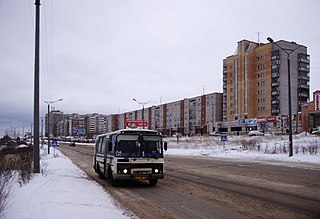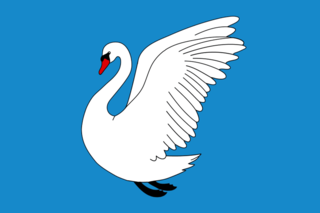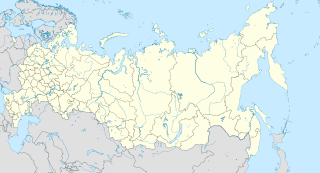
Sovetsk, formerly Kukarka, is a town and the administrative center of Sovetsky District in Kirov Oblast, Russia. Population: 16,598 (2010 Census); 18,167 (2002 Census); 19,368 (1989 Census).

Kirovo-Chepetsk is a town in Kirov Oblast, Russia, located at the confluence of the Cheptsa and the Vyatka Rivers, 20 kilometers (12 mi) east of Kirov. Population: 80,921 (2010 Census); 90,303 (2002 Census); 92,382 (1989 Census).

Luza is a town and the administrative center of Luzsky District in Kirov Oblast, Russia, located on the Luza River, 301 kilometers (187 mi) northwest of Kirov, the administrative center of the oblast. Population: 11,260 (2010 Census); 12,311 (2002 Census); 13,706 (1989 Census).

Murashi is a town and the administrative center of Murashinsky District in Kirov Oblast, Russia, located 112 kilometers (70 mi) northwest of Kirov, the administrative center of the oblast, on the Kirov–Syktyvkar highway. Population: 6,750 (2010 Census); 7,650 (2002 Census); 10,059 (1989 Census).

Nolinsk is a town and the administrative center of Nolinsky District in Kirov Oblast, Russia, located on the right bank of the Voya River, 143 kilometers (89 mi) south of Kirov, the administrative center of the oblast. Population: 9,554 (2010 Census); 10,463 (2002 Census); 10,902 (1989 Census).

Zuyevka is a town and the administrative center of Zuyevsky District in Kirov Oblast, Russia, located 121 kilometers (75 mi) east of Kirov, the administrative center of the oblast. Population: 11,198 (2010 Census); 12,600 (2002 Census); 16,112 (1989 Census).

Kirovo-Chepetsky District is an administrative and municipal district (raion), one of the thirty-nine in Kirov Oblast, Russia. It is located in the center of the oblast. The area of the district is 2,210.27 square kilometers (853.39 sq mi). Its administrative center is the town of Kirovo-Chepetsk. Population: 21,317 (2010 Census); 22,193 ; 39,688 (1989 Census).

Kotelnichsky District is an administrative and municipal district (raion), one of the thirty-nine in Kirov Oblast, Russia. It is located in the west of the oblast. The area of the district is 3,940 square kilometers (1,520 sq mi). Its administrative center is the town of Kotelnich. Population: 15,799; (2010 Census) 20,507 ; 27,712 (1989 Census).

Kumyonsky District is an administrative and municipal district (raion), one of the thirty-nine in Kirov Oblast, Russia. It is located in the center of the oblast. The area of the district is 1,911 square kilometers (738 sq mi). Its administrative center is the urban locality of Kumyony. Population: 17,350 (2010 Census); 19,472 ; 21,445 (1989 Census). The population of Kumyony accounts for 27.8% of the district's total population.

Lebyazhsky District is an administrative and municipal district (raion), one of the thirty-nine in Kirov Oblast, Russia. It is located in the south of the oblast. The area of the district is 1,336 square kilometers (516 sq mi). Its administrative center is the urban locality of Lebyazhye. Population: 8,700 (2010 Census); 11,176 ; 12,414 (1989 Census). The population of Lebyazhye accounts for 38.6% of the district's total population.

Murashinsky District is an administrative and municipal district (raion), one of the thirty-nine in Kirov Oblast, Russia. It is located in the north of the oblast. The area of the district is 3,415.78 square kilometers (1,318.84 sq mi). Its administrative center is the town of Murashi. As of the 2010 Census, the total population of the district was 12,905, with the population of Murashi accounting for 52.3% of that number.

Nemsky District is an administrative and municipal district (raion), one of the thirty-nine in Kirov Oblast, Russia. It is located in the southeast of the oblast. The area of the district is 2,158 square kilometers (833 sq mi). Its administrative center is the urban locality of Nema. As of the 2010 Census, the total population of the district was 7,983, with the population of Nema accounting for 45.7% of that number.

Omutninsky District is an administrative and municipal district (raion), one of the thirty-nine in Kirov Oblast, Russia. It is located in the east of the oblast. The area of the district is 5,171 square kilometers (1,997 sq mi). Its administrative center is the town of Omutninsk. Population: 44,793 (2010 Census); 51,406 ; 59,218 (1989 Census). The population of Omutninsk accounts for 52.7% of the district's total population.

Pizhansky District is an administrative and municipal district (raion), one of the thirty-nine in Kirov Oblast, Russia. It is located in the southwest of the oblast. The area of the district is 1,160.2 square kilometers (448.0 sq mi). Its administrative center is the urban locality of Pizhanka. Population: 11,242 (2010 Census); 13,580 ; 15,220 (1989 Census). The population of Pizhanka accounts for 34.5% of the district's total population.

Tuzhinsky District is an administrative and municipal district (raion), one of the thirty-nine in Kirov Oblast, Russia. It is located in the southwest of the oblast. The area of the district is 1,468 square kilometers (567 sq mi). Its administrative center is the urban locality of Tuzha. Population: 7,688 (2010 Census); 10,396 ; 12,334 (1989 Census). The population of Tuzha accounts for 59.4% of the district's total population.

Urzhumsky District is an administrative and municipal district (raion), one of the thirty-nine in Kirov Oblast, Russia. It is located in the south of the oblast. The area of the district is 3,025 square kilometers (1,168 sq mi). Its administrative center is the town of Urzhum. Population: 27,075 (2010 Census); 33,959 ; 38,836 (1989 Census). The population of Urzhum accounts for 37.7% of the district's total population.

Yuryansky District is an administrative and municipal district (raion), one of the thirty-nine in Kirov Oblast, Russia. It is located in the north of the oblast. The area of the district is 3,031 square kilometers (1,170 sq mi). Its administrative center is the urban locality of Yurya. Population: 20,128 (2010 Census); 22,893 ; 34,311 (1989 Census). The population of Yurya accounts for 28.2% of the district's total population.

Zuyevsky District is an administrative and municipal district (raion), one of the thirty-nine in Kirov Oblast, Russia. It is located in the east of the oblast. The area of the district is 2,820 square kilometers (1,090 sq mi). Its administrative center is the town of Zuyevka. Population: 22,586 (2010 Census); 27,823 ; 36,023 (1989 Census). The population of Zuyevka accounts for 49.6% of the district's total population.

Afanasyevo is an urban-type settlement and the administrative center of Afanasyevsky District of Kirov Oblast, Russia. Population: 3,435 (2010 Census); 3,474 (2002 Census); 4,982 (1989 Census).

Arkul is an urban locality in Nolinsky District of Kirov Oblast, Russia. Population: 2,053 (2010 Census); 2,616 (2002 Census); 3,163 (1989 Census).
























